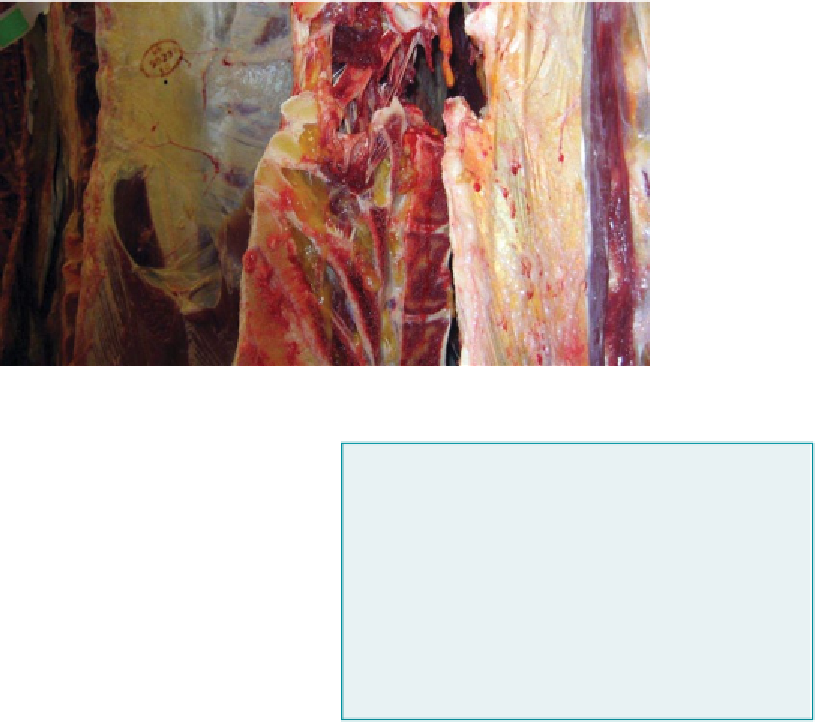Agriculture Reference
In-Depth Information
Figure 9.15
Oedema on bovine shoulder.
Oedema fluid, with its low protein content, is termed
a
transudate
as opposed to an
exudate
of inflammation,
which is rich in protein, leukocytes and fibrin.
When this fluid collects in the peritoneal cavity, it is
called
ascites
; in the pleural cavity,
hydrothorax
; in the
pericardial sac,
hydropericardium
; in the brain,
hydro-
cephalus
; and in the subcutaneous and connective tissue
spaces,
anasarca
. The term
effusion
is also used to denote
an escape of fluid into a part, for example, pericardial
effusion.
Oedema may be
localised
, as in acute inflammation,
photosensitisation and cerebral and pulmonary
oedema;
generalised
as in severe malnutrition, para-
sitic gastroenteritis, fascioliasis and
brisket disease
of
cattle. It may be
inflammatory
or
non-inflammatory
in
origin.
In cases of malnutrition and starvation where there is
severe protein deficiency, oedema is evident in a general-
ised form -
nutritional oedema
.
Oedema may also be produced by an
increased
permeability
of capillary walls as a result of damage by
toxins or to an increased filtrability of the blood. Such
changes are evident in allergic conditions like urticaria
and purpura haemorrhagica and in bacterial diseases
like bowel oedema, malignant oedema, anthrax and
mulberry heart disease.
Obstruction to the lymphatic flow from a part, for
example, by tumours or granulomas, may result in oedema.
In oedema, the affected area is swollen (often several
centimetres in depth and mostly well defined), firm,
painless and pits on pressure. Section incision reveals a
pale yellowish fluid or gelatinous mass from drips which
fluid, which has a tendency to clot.
Localised, minor forms of oedema and ascites and
hydrothorax are of less serious import than anasarca and
Test for oedema
A test for oedema involves the estimation of water content of
bone marrow. This consists of floating pea-sized pieces of fat
from a long bone in alcohol of strengths 32, 47 and 52%.
Marrow containing less than 25% of water will float in each
solution of alcohol, in which case the carcase may be
released provided there are no other abnormalities; if the
water content of the marrow is 50% or more, the marrow
sinks in two or three of the solutions and the carcase is
judged unfit for food.
much easier to judge. Oedema combined with poorness
is probably one of the most difficult decisions to make in
meat inspection. Detention of the carcase for 12 hours is
indicated in all generalised cases while tests are being
undertaken (Fig. 9.15).
If the serous cavities have dried out well and the
carcase has set properly with reasonable or good condi-
tion, the carcase may be passed for food. However, in
anasarca
(oedema) involving the subcutaneous and
connective tissues or any form of oedema accompanied
by emaciation and non-setting, the carcase should be
condemned. (In healthy cattle, the bone marrow con-
tains not more than 25% of water, but in anasarca, it
holds more than 50%.)
Pneumonia and pleurisy
Carcases must be condemned if there are any signs of
systemic change in the viscera, especially the liver, kid-
ney and carcase lymph nodes. If there is no such evi-
dence, condemnation of the carcase cannot be justified,
and stripping of the pleura or removal of the rib cage
may suffice. In almost all cases where it is necessary

